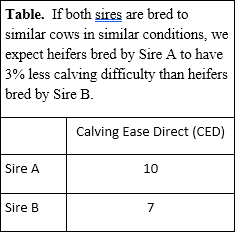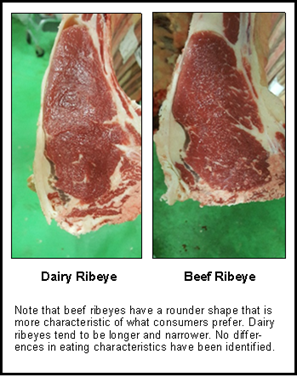Bull Considerations When Selecting a Beef Bull to Breed to Your Dairy Cows/Heifers
Bull Considerations When Selecting a Beef Bull to Breed to Your Dairy Cows/Heifers
Breeding beef sires in a designed breeding program to lower producing dairy cows and/or heifers is not a new concept, but understanding the tools available to assist with selecting the right beef semen may be helpful. The primary selection tool used in beef cattle is Expected Progeny Differences or EPD, which is analogous to PTAs in the dairy industry. The biggest difference is that the dairy industry relies more on selection indices than the beef industry, but we are starting to catch up and some breeds are even developing indices for beef on dairy.
Will Heifers Be Bred to Beef Semen?

Before attempting to select a beef sire to breed to your dairy cows you need to know what group of cattle you plan to breed. The biggest question is likely, will heifers be bred to this sire? Unfortunately, we are beyond the point of just using Angus semen on heifers and feeling reasonably confident that you will not have calving problems; this must be a consideration regardless of which beef breed you choose to use. The best tool available to determine the calving ease potential of a sire is his Calving Ease Direct (CED) EPD. Differences in this EPD reflect the expected percent difference in assisted births, when bred to heifers, with higher values representing reduced calving assistance needed (See table).
When breeding a sire to mature cows the level of CED necessary to avoid assisting births is greatly reduced. There are also significant differences in calving ease ability across the beef breeds with most British breeds having greater calving ease than most Continental breeds. EPD values are not comparable across breed and unfortunately there is not a good method of adjusting Calving Ease Direct EDPs across the breeds.
Frame Size Important for Holsteins
Making the assumption that the calves are destine for the feedlot and eventually marketed as beef, some other traits to consider when selecting a beef sire to breed to dairy cows are muscling, frame/size, growth, feed efficiency (dry matter intake) and perhaps carcass quality. Of these traits the one that is the most breed dependent is the frame/size trait. Larger dairy breeds tend to produce carcasses that are longer than acceptable when hanging on the rail and this should be addressed when selecting a beef sire. For breeding to Holsteins or other large breeds this trait needs to be moderated, but when breeding to Jerseys this would not be a consideration. The best EPD for controlling this would be Yearling Height or Mature Height. If neither of these EPD are available on the breed you are considering, then you need to evaluate the actual height and length of the sire in making your selection decision; fortunately, these traits are highly heritable and this is an acceptable method.

Beef-Dairy Calves have Larger Ribeyes
The only EPD available for muscling in beef cattle is the Ribeye Area (REA) EPD and greater values indicate larger ribeyes measured in square inches. Selecting beef sires with greater values should improve the ribeye area of the offspring and hopefully improve the shape of the ribeye and strip steaks (See figure). There is a correlation between REA and total muscling, but it is not perfect. I would recommend selecting for extreme values for REA and identify sires that also show greater thickness through the hind quarter. If you are planning to sell the calves anytime prior to them hanging on the rail (i.e. feeder calves) then the thickness through the hind quarter takes on greater importance.
Improve Efficiency and Carcass Traits
If you do plan to sell carcasses or have a way to capture value from good feedlot and carcass performance, then selecting for feed efficiency and marbling become important. Selecting for feed efficiency is best done by identifying sires that have high growth rate while simultaneously have lower dry matter intake (DMI). Regardless of when the cattle will be sold, it will be necessary to select a sire with high growth. This is just adding the dimension of finding a sire that also passes on lower DMI. Improving marbling is simpler, just select sires with high Marbling EPD values. Again, there are significant breed differences for marbling without good tools for comparing values across breed.
Breed Indexes
The last topic of discussion is something that is more familiar to dairy producers than beef producers and that is selection indices. Several breeds have developed specific beef on dairy selection indices that take much of the guesswork out of the selection process. Utilizing higher selection index values will assist you in selecting a sire with the better economic potential, but with a caveat. These indices assume you will retain ownership and sell carcasses or sell your calves through a program that will allow you to capture some of the added value.
The bottom line is that using beef sires on your dairy cows can add value to calves. I would encourage you to investigate programs that will reward you for using the right kind of beef sire and capturing at least a portion of the additional revenue that they should generate. However, even if you don’t want to go to the added trouble of selling through a marketing program, just adding some thickness and muscling to the calves, moderating frame size and selecting a sire that should give you piece of mind with calving ease has a lot of value.
- Author: Darrh Bullock
- Printable PDF version
